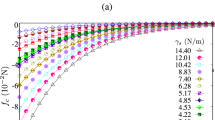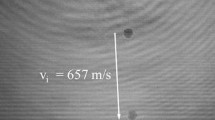Abstract
A combined finite and discrete element method is used to examine the energetics of a two-dimensional micro-particle cluster that impacts a rigid planar wall. The method combines conservation principles with an elastic-viscoplastic and friction constitutive theory to predict thermomechanical fields within particles resulting from both particle-wall and particle-particle contact. Emphasis is placed on characterizing the temporal and spatial partitioning of cluster energy with impact angle (0◦ ≤ \({\phi}\) ≤ 80◦, where \({\phi}\) = 0◦ corresponds to normal impact). Predictions for a close-packed cluster of well-resolved particles having an average initial radius and uniform speed of 50μm and 300 m/s indicate that particles adjacent to the wall experience the largest plastic and friction work. Friction significantly affects cluster kinetic energy, but minimally affects its elastic strain energy and plastic work. Local temperature rises in excess of 900K are predicted for \({\phi}\) = 0◦, increasing to 4,400K for approximately \({\phi}\) > 60◦, with most of the cluster mass (≈98%) experiencing temperature rises less than 200K due to plastic work. These predictions highlight the importance of friction work as a heating mechanism that may induce combustion of energetic clusters. Sensitivity of the cluster response to its initial packing configuration is demonstrated.
Similar content being viewed by others
References
Andersen WH (1981) Role of friction coefficient in the frictional heating ignition of explosives. Propellants Explos 6: 17–23
Baer MR, Nunziato JW (1986) A two-phase mixture theory for the deflagration-to-detonation transition in reactive granular materials. Int J Multiph Flow 12: 861–889
Bathe KJ, Bouzinov PA (1997) On the constraint function method for contact problems. Comput Struct 64(5/6): 1069–1085
Bonet J, Wood RD (2000) Nonlinear continuum mechanics for finite element analysis. Cambridge University Press, Cambridge
Bowden FP, Gurton OA (1949) Initiation of solid explosives by impact and friction: the influence of grit. Proceedings of the royal society of London, series A. Math Phys Sci 198: 337–349
Brach RM (1991) Mechanical impact dynamics: rigid body collisions. Wiley, New York
Brach RM (1998) Formulation of rigid body impact problems using generalized coefficients. Int J Eng Sci 36: 61–71
Deguet A, Joukhadar A, Laugier C (1998) A collision model for deformable bodies. IEEE Int Conf Robot Autom 1: 636–641
Farahani K, Mo DM, Vafai A (2000) A solution method for general contact-impact problems. Comput Methods Appl Mech Eng 187: 69–77
Gonthier KA (2003) Modeling and analysis of reactive compaction for granular energetic solids. Combust Sci Technol 175: 1679–1709
Heinstein MW, Mello FJ, Attaway SW, Laursen TA (2000) Contact-impact modeling in explicit transient dynamics. Comput Methods Appl Mech Eng 187: 621–640
De Jalon JG, Bayo E (1993) Kinematic and dynamic simulation of multi-body systems: the real time challenge, Mechanical Engineering Series. Springer, New York
Johnson KL (1985) Contact mechanics. Cambridge University Press, Cambridge
Khoei AR, Keshavarz SH, Khaloo AR (2008) Modeling of large deformation frictional contact in powder compaction processes. Appl Math Model 32: 775–801
Kim SW (1999) Contact dynamics and force control of flexible multi-body systems. Ph.D. Thesis, Department of Mechanical Engineering, McGill University, Montreal
Kraus PR, Kumar V (1987) Compliant contact models for rigid body collisions. IEEE Int Confer Robot Autom 2: 1382–1387
Kumar DR, Kumar RK, Philip PK (1998) Simulation of dynamic compaction of metal powders. J Appl Mech 85(2): 767–775
Laursen TA (2003) Computational contact and impact mechanics. Springer, Berlin
Lewis RW, Gethin DT, Yang XS, Rowe RC (2005) A combined finite-discrete element method for simulating pharmaceutical powder tableting. Int J Numer Methods Eng 62(7): 853–869
Logan DL (1986) A first course in the finite element method. PWS-KENT, Boston
Lubliner J (1990) Plasticity theory. Macmillan Publishing Company, New York
Ma O (1995) Contact dynamics modeling for the simulation of the space station manipulators handling payloads. IEEE Int Confer Robot Autom 2: 1252–1358
McAfee JM, Asay BW, Campbell W, Ramsay JB (1989) Deflagration to detonation transition in granular HMX. In: Proceedings of the ninth (International) detonation symposium, pp 265–278
Meng XN, Laursen TA (2002) Energy consistent algorithms for dynamic finite deformation plasticity. Comput Methods Appl Mech and Eng 191: 1639–1675
Menikoff R, Kober E (1999) Compaction waves in granular HMX, Los Alamos Report, LA-13546-MS, Los Alamos National Laboratory, Los Alamos, New Mexico
Munjiza A, Andrews KRF (2000) Discretised penalty function method in combined finite-discrete element analysis. Int J Numer Methods Eng 49: 1495–1520
Munjiza A (2004) The combined finite-discrete element method. Wiley, New York
Munjiza A, Andrews KRF (1998) NBS contact detection algorithm for bodies of similar size. Int J Numer Methods Eng 43(1): 131–149
Panchadhar R (2009) Meso-scale heating predictions for weak impact of granular energetic materials. Ph.D. Dissertation, Louisiana State University
Powers JM, Stewart DS, Krier H (1990) Theory of two-phase detonation—part I: modeling. Combust Flame 80: 264–279
Vukobratovic MK, Potkonjak V (1999) Dynamics of contact tasks in robotics. Part I: general model of robot interacting with environment. Mech Mach Theory 34: 923–942
Zavaliangos A (2002) A multiparticle simulation of powder compaction using finite element discretization of individual particles. Mater Res Soc Symp Proce 731: 169–176
Author information
Authors and Affiliations
Corresponding author
Rights and permissions
About this article
Cite this article
Panchadhar, R., Gonthier, K.A. Energy partitioning within a micro-particle cluster due to impact with a rigid planar wall. Comput Mech 44, 717–744 (2009). https://doi.org/10.1007/s00466-009-0404-5
Received:
Accepted:
Published:
Issue Date:
DOI: https://doi.org/10.1007/s00466-009-0404-5




